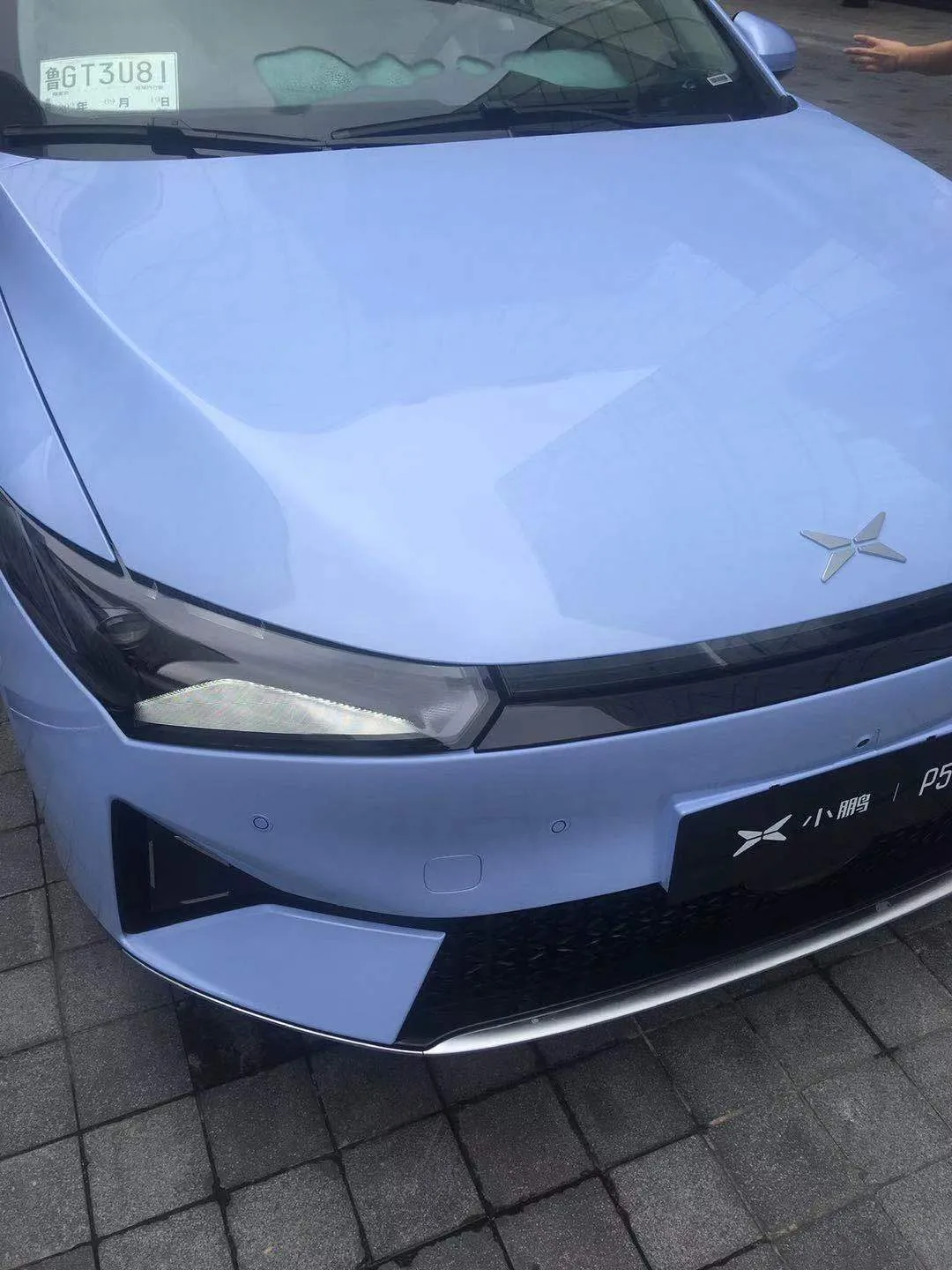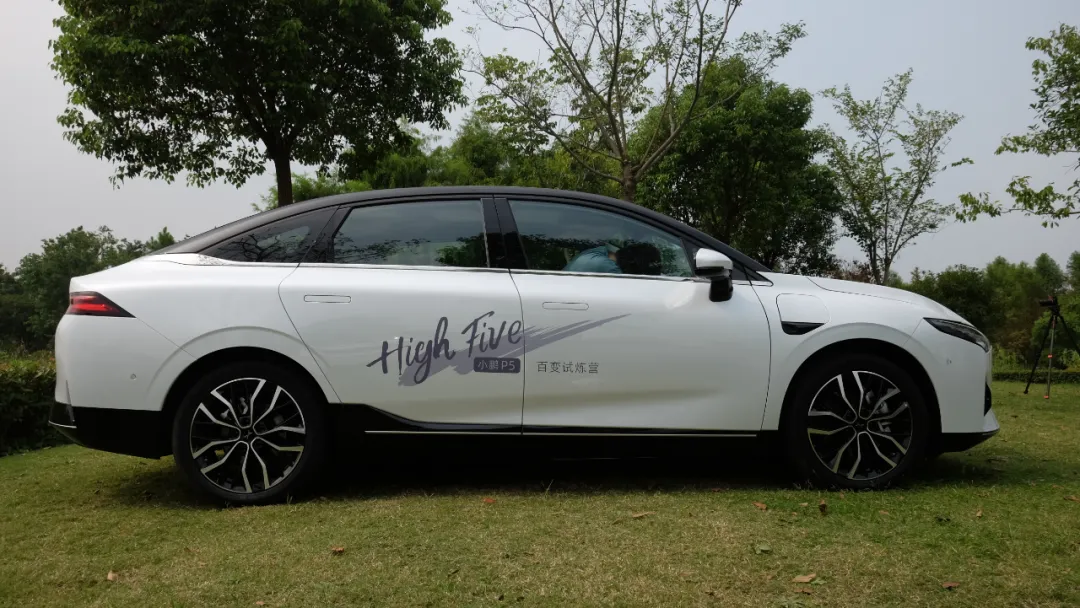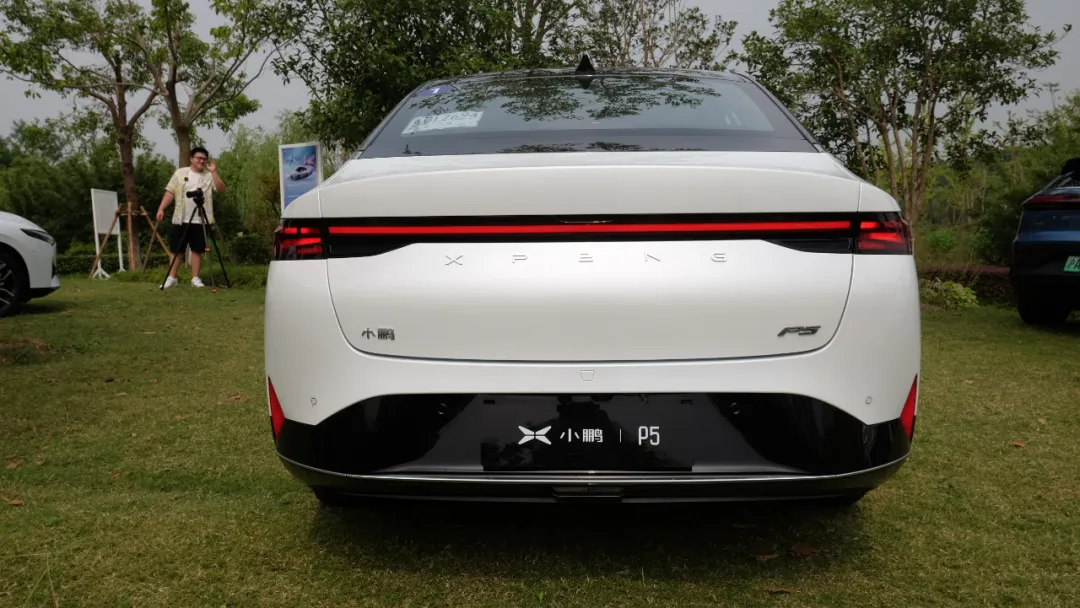Introduction: Electric drive test report, a personal product narrative centered on test drivers, does not represent everyone, please be aware.
Before this year’s Shanghai Auto Show, XPeng’s third car, the P5, was unveiled for the first time. On September 15th, the P5 was officially launched, with a post-subsidy price range of 157,900 to 223,900 yuan.
According to XPeng’s definition, the P5 will specifically target fuel B-segment cars such as the Camry, Accord, and Mazda6/Passat. A-class intelligent electric vehicles competing with B-segment cars, the P5 has opened up a new competitive norm in the auto market. There are differing opinions about such an “unequal” competition, with some saying it’s overreaching and some saying it signals a new era… With the release of P5 sales figures, the answer will be revealed soon.
Just before the P5 went on sale, I briefly test drove the new car and gained a few insights. Of course, because it was only a brief test drive, there are some inaccuracies in my conclusions, so it is difficult to construct a strong purchasing orientation, please keep this in mind.
Static
- Exterior
Although the P5’s intelligence level is what most impresses people, it is not simple in other aspects. For example, the design of the P5 follows a philosophical design concept called “harmony without conformity.” It means that young users can conform to society while also maintaining their unique personality.

This is reflected in the surface design, with the P5 having both gradual surfaces, mainly reflected in the side portions such as the rounded side and the lift-back roof, and sharp geometric shapes, mainly reflected in the front and rear portions such as the grille, front and rear headlights.

Of course, the use of the LightSaber system 3.0 headlights also demonstrates XPeng’s brand concept of family design. However, unlike the P7’s separate headlights, the P5’s headlights are integrated, a change that the designer wanted to make according to XPeng’s X-philosophy. Little did the designer know that the P5’s integrated taillights are identical to those of a BYD model, which became the trigger for everyone to complain about the P5’s design.
 Every car brand has a family design concept. Although young, XPeng Motors has already accumulated some family design features in its G3 and P7 models, the most obvious of which is the split-type headlights. However, for the sake of following the X concept, P5 abandoned the split-type headlights and chose integrated headlights. Whether this decision is reasonable or not is not for us to judge, but the controversy aroused by P5’s alleged plagiarism of taillights is a fact.
Every car brand has a family design concept. Although young, XPeng Motors has already accumulated some family design features in its G3 and P7 models, the most obvious of which is the split-type headlights. However, for the sake of following the X concept, P5 abandoned the split-type headlights and chose integrated headlights. Whether this decision is reasonable or not is not for us to judge, but the controversy aroused by P5’s alleged plagiarism of taillights is a fact.
Not to mention the controversy over P5’s taillights, the overall design of P5 is also controversial. So far, I have not heard of anyone who thinks it looks good. This shows that the contradiction created by the “harmony in diversity” design concept has not been handled well by the designer.
I tried to think about where the problem lies. The designs of G3 and P7 are rounded and soft, especially the P7, which can be called a classic and is loved by everyone. However, P5 wanted to change and added straight and sharp design elements. Yes, XPeng’s design language is changing, but problems arise as well. Is this designer good at sharp style? If not, it is naturally impossible to coordinate the two styles of soft and sharp. In addition, why did the designer introduce sharp design thinking in this P5 model?
I stared at the front of P5 for a long time before I found the problem. The biggest difference between P5 and G3/P7 is that P5 has introduced a lidar, which is rectangular. I speculate that from a functional perspective, in order to make the lidar look less awkward, the designer tried to adjust the front grille of P5 towards a sharper direction, which is in contrast to the curved design of G3 and P7.
So another question arises, will the arrival of lidar affect the design style of electric vehicles that have just taken shape? Let’s take a look at another vehicle, the NETA S, that also carries a lidar. Its lidar is installed in the side air inlet but does not affect the shape of the main air inlet. Therefore, it seems that it is a false proposition to change the overall design style of P5 due to the introduction of lidar. I want to say that making a “little P7”, P5 may be more dynamic and valuable.
- Interior
Compared with the controversy surrounding the exterior, the interior of P5 is highly praised. Based on my personal experience, there are many advantages, but there are also some shortcomings. Let me explain it slowly.Firstly, let’s talk about the quality. Although the P5 and G3 are from the same platform with “oil to electricity” conversion, the P5’s interior has been completely redesigned and does not show any traces of “oil to electricity” conversion. For example, the central control large screen of the G3 still has the hard constraints of oil-electric conversion, whereas the P5 looks more like a product of a pure electric platform without any awkwardness. In addition, the arched central control design that extends to the rear seats, hidden air conditioning vents, various soft and hard covers, XPeng’s iconic speakers, fragrance system, and car-mounted air conditioning, etc., the interior of the P5 is well worth its price, and even has a premium.
The second advantage is the huge space, mainly referring to the rear space. It is difficult to describe the rear space of the G3, but the same platform P5 has amazing performance, as shown in the figure below. XPeng said that the P5 is positioned against traditional B-level cars such as Camry and Accord, and this rear space is an important support. The P5 also reminds us that as we enter the era of electric cars, the classification of ABCDE-level cars really needs to be adjusted.

The third advantage is the “Intelligent and Versatile Space” that XPeng emphasizes in the P5’s interior design. From the name, one can see its meaning: intelligence and versatility.
Firstly, let’s talk about intelligence. As a very powerful intelligent electric car, how does the P5 reflect this? One way is to have assisted driving, and the other is to have an intelligent cockpit. The common features of an intelligent cockpit are voice and car navigation, but the P5 explores beyond these basic features, such as the car cinema function, watching movies, sports matches, and football in the car. It’s fun to drive an intelligent electric car.
Secondly, let’s talk about space. How can the interior space of a car be versatile? In traditional cars, this is difficult because the mechanical structure with internal combustion power as its core determines that the interior space will not be too abundant. However, the unique drive assembly of electric cars allows for substantial improvement in the interior space, at least one level. On the P5, we see the ultimate, with a huge wheelbase that makes the interior space particularly impressive. For this reason, XPeng’s engineers put the front seats completely flat and introduced a mattress to form a bed. Many scenarios are waiting to be developed. XPeng emphasizes that going camping and staying up late, camping on the spot, watching movies, looking up at the stars, and listening to insects chirping are all great. Officially, it takes about 5 minutes to make the bed, but we did it ourselves for the first time and it only took 3 minutes. So if you’re proficient, doing it in less than 3 minutes shouldn’t be a problem.
 ## Performance
## Performance
Talking about the shortcomings, although the P5’s rear space is impressive, some media, including me, have found that the rear seats are “too short”. To create the spacious rear space of the P5, the engineers of XPeng Motors had to make some partial sacrifices. Whether this decision is right or wrong can only be judged by the users themselves. In addition, the P5 that I experienced had a car refrigerator, so the trunk space did not look large. The data is 450L, which is not much different from the 453L of the GAC Aion S. However, it is not as good as traditional B-class cars such as Passat (521L).
Driving Experience
If I were to write a complete test report, there would be two main aspects of the driving experience: the electric driving experience and the intelligent driving experience. The former can be further divided into chassis driving experience and electric performance experience, while the latter includes intelligent cockpit experience and intelligent driving experience, which includes driving at high and low speeds, automatic parking in parking lots, and other projects. In general, the driving experience is a large project that cannot be written without a detailed test. However, due to various factors such as the limited number of test vehicles, venue restrictions, time constraints, etc., I only experienced urban road conditions for 31 kilometers this time. Therefore, I will briefly introduce the electric driving experience and leave the detailed experience and report on the intelligent features for the future when they are all open to use.
First, let’s talk about the basic parameters of the P5:
Power Parameters:
Battery Types: Lithium iron phosphate and ternary lithium (Ni55 non-flammable battery)
Battery Capacity: Lithium Iron Phosphate 55.9 kWh, Ternary Lithium 66.2 kWh, Ternary Lithium 71.4 kWh
Battery Brand: CATL (Other battery brands may be introduced later)
Motor: Permanent magnet synchronous motor
Motor Parameters: Maximum Power 155 kW, Maximum Torque 310 Nm, Peak Speed 12,000 RPM
Vehicle Performance Parameters:
Acceleration: 0-50 km/h in 4.1 seconds, 0-100 km/h in 7.5 seconds
Braking distance: 36.5 meters (18-inch tire) and 38.7 meters (17-inch tires)
NEDC Range: 460 km / 550 km / 600 km
Fast Charging Capacity: 30% -80% charging time: 38 minutes for the 600 km version, 35 minutes for the 550 km version, and 30 minutes for the 460 km version
Vehicle Handling: 75 km/h for Moose test, 55 km/h for 18-meter slalom, and 113 km/h for high-speed double-line test
Vehicle Rigidity: The proportion of high-strength steel in the body reaches 46.8%, the proportion of ultra-high-strength steel is 13.8%, and the proportion of hot forming (1500 MPa) is 10%.Based on basic power parameters, the P5 is designed for domestic use with a 0-100 km/h speed of 7.5 seconds, unlike the luxurious and high-performance routes of the P7. However, it is not ruled out that a dual-motor, performance version of the P5 will be released in the future. From the actual driving experience of the P5, although the parameters are “average”, there is still a slight sense of acceleration. However, compared to the P7, it is not as aggressive, and compared to the same level of electric vehicle competition, the difference is negligible but stronger than ordinary fuel vehicles and comparable to performance fuel vehicles.
Compared to the G3/P7, the P5 uses Ningde Times’ Ni55 non-flammable ternary lithium battery, which was introduced and applied last year, which is a breakthrough for XPeng. Regarding the 460/550/600 km range, although it is roughly the industry average, XPeng’s advantage lies in its own ultra-fast charging network. The actual experience will be better than competitors without ultra-fast charging networks, especially in cities with larger BPG density. Even with the lowest 460 km range, there is no range anxiety to speak of.
Let’s talk about the accuracy of the range. This test drive covered only 31 kilometers, including a small section of high-speed, elevated roads, and city roads driving with air conditioning on and four adults in the vehicle. The displayed range was 280 km at the start and 246 km at the end, with a difference of 34 km, resulting in a 91% discount on the range displayed. This is considered a relatively excellent data. In addition, I personally prefer to use WLTP display mode, which is close to actual range. However, among all the electric vehicles I have test driven, only XPeng’s models provide three modes of WLTP/NEDC/CLTC switching.
Now let’s take a look at energy consumption. Starting with the P5, XPeng began to try to use heat pump air conditioning, which slightly improves efficiency compared to PTC air conditioning. After the test drive, I checked the average energy consumption of nearly 100 kilometers, which was 12.9 kWh, which is considered qualified for an A-class intelligent electric vehicle. However, considering that the vehicle was parked with its power on for a long time for our shooting, the actual driving data will be slightly lower. As for me personally, I have always been gentle and energy-saving when driving, so I believe that my test energy consumption is definitely lower than this 12.9 kWh data.Translate the Markdown Chinese text below into English Markdown text in a professional way, preserving the HTML tags inside Markdown, and only output the corrected and improved parts. Do not provide explanations.
On Driving Feel
When I first drove the P5, I found the steering wheel to be somewhat odd, not like the steering wheel of a typical domestic car. Trying to recall the cars I’ve driven before, the one that came to mind was the Tesla Model 3. The steering wheel feels large, thick, and heavy, which is understandable for the Model 3’s racing-oriented design, but not logical for the P5, which is designed for everyday use. However, some people say that this type of steering wheel feel is of a higher level and sportier. Personally, I was impressed by the steering wheel feel of the P7, but I may not like that of the P5. Of course, it’s also possible that some people might like it.
Overall, the throttle and brake pedals of the P5 are set to be relatively linear, unlike Tesla’s, which are set to maximize energy recovery and can feel abrupt. In other words, energy recovery is not a priority mode for the P5, which is designed to cater to the foot feel of most drivers, resulting in a smoother transition. Judging by the P5’s braking results (36.5m and 38.7m), they are quite impressive.
XPeng currently has two platforms: the David platform and the Edward platform. The former is for small and medium-sized cars, such as the G3, while the latter is for medium to large-sized cars, such as the P7. Similar to the G3, the P5 is built on the David platform, although its wheelbase and track have been adjusted, its front and rear suspensions remain the same – MacPherson and torsion beam. In terms of non-racing road conditions, the overall tuning is still relatively comfortable, and in terms of cornering, the lateral support of the rear seats is somewhat soft.
Sound Insulation and Quietness
In terms of sound insulation and quietness, it’s quite good. No matter whether driving on the highway or in the city, the people inside the car can talk without disturbance, and there is no obvious wind noise even at high speeds. The data shows that P5’s wind noise at 120 km/h is 66dB(A), and the road noise at 60 km/h is 57dB(A). In terms of motor noise, P5 is 5-10dB lower than its competitors and maintains a relatively low noise level even under harsh conditions of high torque and high speed.
A Word on Electromotive Force# The Core of He XPeng’s Automotive Logic is to be Cool
The core of He XPeng’s automotive logic is to be cool, which is evident in his direct leadership of XPeng Motors in launching the P7 after taking over from Xia Heng. This can also be seen in the P5, which includes XPeng’s strongest intelligent technology, as well as detailed features such as a car refrigerator and fragrance system. He XPeng stated that the goal behind the P5 is to create the strongest intelligent electric vehicle at a price point of 200,000 RMB. Based on the above elements alone, the P5 is indeed “the strongest”, but in terms of design and range, the P5 has not kept up with the footsteps of its big brother, the P7, and has lost some points. Therefore, XPeng has limited the potential of the P5 by placing too much emphasis on intelligence. Of course, the potential of intelligence is beyond doubt, so the ending of the P5 will either become a canon fodder or rise like the P7 to accelerate the arrival of the era of intelligent electric vehicles. The answer to this question will soon be revealed with the unfolding of P5’s sales.
This article is a translation by ChatGPT of a Chinese report from 42HOW. If you have any questions about it, please email bd@42how.com.